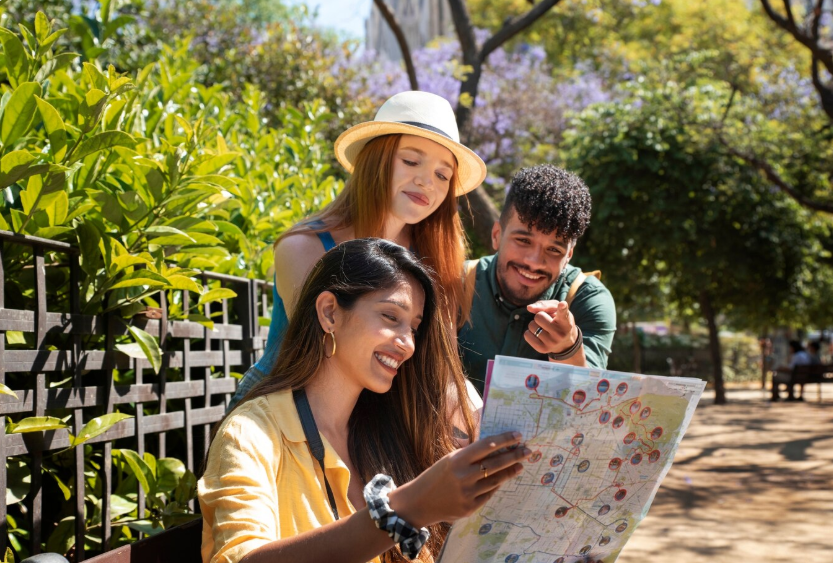
by Dulce Navarro | May 23, 2025 | Countries, Culture, Lifestyle, Traditions, Travel, Worldwide
The Power of Cultural Immersion Travel: Experiencing the World Authentically
In today’s interconnected world, travel has become more than a luxury—it’s a doorway to deeper understanding, empathy, and personal transformation. For company directors, global entrepreneurs, and curious professionals, cultural immersion travel presents an unparalleled opportunity to authentically experience life in another part of the world while enriching both personal and business perspectives.
Why Cultural Immersion Travel Matters
Unlike typical tourism, which often revolves around sightseeing and pre-packaged experiences, cultural immersion travel dives beneath the surface. It focuses on living as the locals do, understanding their customs, tasting their everyday cuisine, and participating in their daily routines. This form of travel fosters a greater appreciation for diversity and helps dismantle stereotypes, all while building stronger interpersonal and intercultural communication skills.
Benefits Beyond Sightseeing
- Deeper Cultural Understanding: Immersive travel allows individuals to see the world through a different lens. By living within a community, travelers gain insights into traditions, values, and social structures that define that culture.
- Stronger Emotional Intelligence: Experiencing cultural norms firsthand can challenge assumptions and cultivate patience, adaptability, and open-mindedness—key traits for business and leadership success.
- Professional Edge: Leaders who understand global cultures are better positioned to negotiate, collaborate, and innovate on an international scale.
- Language Skills: Being surrounded by a new language accelerates learning and helps you grasp the nuances of communication far better than any classroom setting.
How to Travel Authentically
To truly immerse yourself in a new culture, it’s important to approach travel with intentionality and openness. Here are some practical ways to ensure your experience is meaningful:
1. Live Like a Local
Skip the hotels and stay in locally owned accommodations or with host families. Explore neighborhoods off the tourist map. Shop at local markets and try regional dishes at family-run eateries.
2. Participate in Cultural Activities
Whether it’s attending a traditional cooking class in Thailand, participating in a village ceremony in Ghana, or helping with olive harvests in Italy, hands-on experiences bring cultural values to life.
3. Learn Basic Language Skills
Even learning a few essential phrases can go a long way in breaking down barriers and showing respect. Locals often appreciate the effort and may open up more readily.
4. Volunteer or Work Abroad
Volunteering or working abroad provides direct engagement with the local community, fostering mutual understanding and growth. It’s also a fantastic way to gain new professional perspectives.
5. Be a Respectful Observer
Observe local customs, dress appropriately, and avoid behaviors that may be considered offensive. Always ask questions with curiosity and humility.
Real Impact of Immersive Travel
One of the most powerful aspects of cultural immersion is the ability to carry those lessons home. Many travelers find themselves transformed—more empathetic, globally conscious, and aware of their role in the broader human experience. These shifts are particularly relevant for leaders who aim to inspire inclusive, culturally sensitive organizations.
Moreover, as sustainability and responsible travel gain momentum, immersion travel supports local economies more directly. Spending money on community-run projects, fair-trade artisans, and neighborhood businesses contributes to ethical tourism and mutual prosperity.
Learning New Languages as an Expat: Strategies for Quick Success
Moving to a new country can be both thrilling and overwhelming. One of the most valuable skills for adapting quickly is learning the local language. Here are a few proven strategies:
- Immerse Yourself Daily: Surround yourself with the language in everyday situations—listen to local radio, watch TV shows, read newspapers, and engage in conversation with locals.
- Use Language Apps: Tools like Duolingo, Babbel, or Memrise are excellent for daily practice and vocabulary building.
- Take Structured Classes: Sign up for language courses designed specifically for expats. Many community centers offer immersive programs at various levels.
- Hire a Language Coach: A private tutor or coach can tailor lessons to your specific needs and help correct pronunciation and grammar in real time.
- Practice Without Fear: Embrace mistakes and speak as much as possible. Locals generally appreciate the effort, and it’s the quickest way to improve.
Language learning is not just about communication—it’s a powerful gateway to understanding the culture, forging authentic connections, and fully enjoying your expat experience.
Stay Connected for More Travel and Lifestyle Inspiration.
For more insights into travel, culture, and lifestyle tips, follow me on @salvadorordorica. If you’re seeking professional translation and localization services to enhance your global ventures, visit The Spanish Group — your trusted partner in bridging cultures worldwide.

by Dulce Navarro | May 22, 2025 | Culture, Languages, Traditions, Travel, Work
Language and Identity: How Words Shape Who We Are
Language is far more than a tool for communication. It is a vessel for memory, emotion, and belonging. The words we use shape how we see ourselves and how others perceive us. From the lullabies of our childhood to the professional vocabulary we acquire in our careers, language carries cultural codes, personal history, and social meaning. In many ways, language is identity.
The Personal Impact of Language
From our earliest days, language helps define our worldview. A child raised in different linguistic environments will experience thought, emotion, and memory differently. For example, some languages emphasize community over the individual, subtly influencing how speakers value relationships and independence. Others encode gender or time in unique ways, affecting perception and expression.
Moreover, the language we speak often determines our sense of belonging. Immigrants or expats, for instance, may feel deeply rooted to their mother tongue, even as they strive to learn a new language in their adopted country. The process of language acquisition in adulthood can feel like reconstructing identity—letting go of certain expressions and adopting new ones that reflect a new cultural context.
Multilingualism and the Fluidity of Identity
People who speak more than one language often experience different facets of their personality depending on the language they’re using. A person may feel more assertive when speaking English but more expressive or emotionally connected when speaking Spanish. This phenomenon is not imagined—it has been studied extensively and reflects the unique emotional and cultural associations tied to each language.
Multilingual individuals often navigate these linguistic shifts seamlessly, adapting their tone, gestures, and social behavior depending on the cultural norms embedded in each language. In this way, identity becomes layered, dynamic, and adaptable—a powerful advantage in a globalized world.
Language and Cultural Identity
Language plays a critical role in preserving cultural identity. It carries folklore, traditions, humor, and history. When a language disappears, so too does a unique way of seeing the world. That’s why indigenous communities and cultural institutions place such importance on language revitalization efforts.
For diasporic communities, language becomes an anchor—a way to stay connected to roots, family, and heritage. Even generations born outside their country of origin often carry fragments of the ancestral language, using it during holidays, ceremonies, or to connect with older relatives. It serves not only as communication but as a bridge between generations and cultures.
The Role of Language in Self-Expression
Every person uses language to express who they are, what they believe, and how they feel. The vocabulary we choose can signal our education, profession, region, or even social values. For artists, writers, and creatives, language is their medium of expression—each word a brushstroke painting a piece of their inner world.
In a professional setting, language also becomes part of one’s brand and authority. The ability to articulate ideas clearly and persuasively can define leadership and credibility. For this reason, effective communication training and language development are essential tools for personal and professional growth.
Language, Power, and Social Identity
Language is also tied to power and social dynamics. The way we speak can either grant us access or place us at a disadvantage. Accents, dialects, and linguistic choices are often subject to social bias—sometimes carrying prestige and other times, stigma. This makes language a site of both empowerment and marginalization.
By acknowledging this, we can challenge assumptions and broaden our acceptance of diverse ways of speaking. It also underscores the importance of inclusive communication, especially in multicultural teams and global workplaces where linguistic diversity should be embraced, not corrected.
Language in the Digital Age
The digital era has introduced new layers to our linguistic identity. Emojis, slang, hashtags, and abbreviations form a new global language of immediacy. Social media has created unique online dialects, shaping how younger generations express themselves and interact across cultures.
At the same time, digital communication has accelerated language evolution. Terms can go viral overnight, and new expressions emerge regularly. While this fluidity allows for innovation, it also raises questions about the preservation of linguistic heritage. Balancing modern expression with respect for tradition is a new frontier for language and identity.
Learning New Languages as an Expat: Strategies for Quick Success
For expats, learning a new language isn’t just about survival—it’s about integration. It allows for a deeper understanding of the culture and facilitates authentic relationships with locals. But mastering a new language can be challenging, especially in adult life.
- Immerse Yourself Fully: Surround yourself with the language—watch local news, listen to music, and read newspapers in your target language.
- Practice Daily Conversation: Speak with locals, even if you make mistakes. Fluency is built through real interaction, not perfection.
- Take a Structured Course: Consider a language school or online platform that offers consistent, goal-oriented lessons.
- Use Flashcards and Apps: Tools like Anki, Duolingo, or Babbel can reinforce vocabulary and grammar at your own pace.
- Join Community Groups: Whether online or in-person, language exchange groups and cultural clubs are great for practice and social support.
Learning a language opens doors—both personally and professionally. It allows you to feel at home abroad, connect more deeply, and gain confidence in navigating your new environment. Most importantly, it reinforces that language and identity are always evolving, and there’s power in embracing that journey.
Stay Connected for More Travel and Lifestyle Inspiration.
For more insights into travel, culture, and lifestyle tips, follow me on Instagram @salvadorordorica. If you’re seeking professional translation and localization services to enhance your global ventures, visit The Spanish Group — your trusted partner in bridging cultures worldwide.

by Dulce Navarro | May 22, 2025 | Countries, Culture, Languages, Traditions
How Translation Strengthens Cultural Connection Across Borders
In today’s interconnected world, businesses, travelers, and expats are increasingly navigating across borders. While technology has made the world smaller, language remains one of the most significant barriers to true cultural understanding. Translation is not just a tool for communication—it is a vital bridge that connects people, values, and traditions. Whether it’s through literature, commerce, or social exchange, translation plays a key role in fostering cultural connection across diverse communities.
The Role of Translation in a Globalized World
Translation allows ideas, philosophies, and innovations to travel beyond their countries of origin. When a business expands into a new market, accurate translation ensures that its message, brand, and values are not lost—or worse, misinterpreted. For individuals, translation helps in accessing foreign literature, enjoying international films, and understanding global news, which all contribute to a deeper understanding of other cultures.
For governments and NGOs, translation is critical in diplomacy and international aid. It fosters clear dialogue and respectful collaboration, ensuring that policies and initiatives are implemented with cultural sensitivity and mutual understanding. Translation, in this regard, isn’t merely about words—it’s about intent, context, and connection.
Preserving Culture Through Language
Language is the essence of culture. Through language, people pass down stories, preserve history, and maintain a shared identity. Translation makes this possible on a global scale. When indigenous texts or traditional folklore are translated, it protects those narratives from being lost over time or limited to a single region. It also invites global audiences to appreciate the richness of cultural diversity.
For example, the translation of ancient texts such as the Bhagavad Gita, The Odyssey, or Chinese poetry has opened doors for cross-cultural admiration and academic study. These works shape global literature and offer insights into the spiritual and philosophical roots of different civilizations. In modern times, translating regional music, films, and social media content helps local cultures thrive in a global setting.
Business, Branding, and Localization
For international businesses, translation is no longer an optional luxury—it’s a necessity. However, effective translation goes beyond converting words from one language to another. It involves localization, which is the adaptation of content to align with the cultural nuances, preferences, and expectations of a specific region. This includes modifying colors, idioms, humor, measurements, and even design layout.
When done correctly, localization creates a sense of familiarity and trust with local audiences. Companies that invest in high-quality translation and localization are better positioned to build long-term relationships with international customers. It reflects cultural respect and demonstrates a commitment to delivering a thoughtful customer experience, regardless of geography.
Translation as a Tool for Inclusion
Beyond business, translation also promotes inclusion in multicultural societies. In cities with diverse populations, public services, legal systems, and healthcare providers rely on translation to ensure equal access to information. Translating materials into multiple languages allows all residents—regardless of their native language—to participate fully in civic life.
Moreover, educational institutions benefit from translated materials to support international students, ensuring they are not left behind academically or socially. This fosters a learning environment where diversity is embraced and celebrated.
Technology and the Future of Translation
Modern technology has revolutionized translation. Tools like AI-powered translation software, machine learning, and real-time interpretation apps have made it easier than ever to communicate across languages. However, technology is not a complete substitute for human expertise—especially when cultural nuance and emotional tone are involved.
Professional translators combine linguistic knowledge with cultural insight, ensuring that every word and phrase conveys the right meaning and intention. As global communication continues to expand, the demand for skilled translation services will only grow, especially in areas like international law, healthcare, marketing, and literature.
Learning New Languages as an Expat: Strategies for Quick Success
For expats living abroad, learning the local language is one of the most powerful ways to connect with the host culture. While translation services provide crucial support, making the effort to speak and understand the local language deepens your integration and builds meaningful relationships.
- Immerse Yourself Daily: Use local media—TV, radio, and newspapers—to get used to the natural rhythm of the language.
- Take a Structured Course: Language apps are useful, but enrolling in an in-person or online course gives you discipline and feedback.
- Practice with Locals: Engage in everyday conversations, even if you make mistakes. Most locals appreciate the effort.
- Label Your Environment: Use sticky notes around your home to reinforce vocabulary in a visual way.
- Join Language Exchange Groups: These are excellent for meeting people and learning through informal, social interaction.
Language acquisition is a journey, but the rewards are immeasurable—from increased confidence to career opportunities and lifelong friendships. The more effort you put into learning the language, the richer your cultural experience will be.
Stay Connected for More Travel and Lifestyle Inspiration.
For more insights into travel, culture, and lifestyle tips, follow me on Instagram @salvadorordorica. If you’re seeking professional translation and localization services to enhance your global ventures, visit The Spanish Group — your trusted partner in bridging cultures worldwide.

by Dulce Navarro | May 21, 2025 | Culture, Languages, Traditions
Protecting Endangered Languages: Why Every Word Counts
In our rapidly globalizing world, over 7,000 languages are spoken today, yet nearly half of them are at risk of disappearing within a few generations. Language is more than a tool for communication—it’s a vessel of culture, history, identity, and community. When a language dies, it takes with it unique worldviews, traditional knowledge, and cultural richness that can never be fully recovered. For companies, governments, and individuals alike, protecting endangered languages is not only a moral and cultural obligation, but a strategic necessity in fostering diversity, inclusion, and innovation.
The Value of Linguistic Diversity
Each language reflects a distinct perspective on the world. Indigenous languages, for example, often contain knowledge about local ecosystems, medicinal plants, and sustainable living practices that are not documented anywhere else. These languages serve as keys to unlocking centuries of accumulated wisdom, passed down through generations via storytelling, rituals, and everyday speech.
Preserving linguistic diversity promotes cognitive flexibility and intercultural empathy. Multilingual societies are more adept at navigating cross-cultural challenges, and multilingual individuals enjoy cognitive benefits such as improved memory, problem-solving, and multitasking skills. In business, a multilingual workforce can tap into a broader market, enhance customer service, and foster better relationships with clients from different linguistic backgrounds.
Causes Behind Language Endangerment
Several factors contribute to language decline, including urbanization, globalization, political marginalization, and the dominance of global languages like English, Spanish, and Mandarin. Children in minority language communities often grow up in education systems that prioritize dominant languages, leaving their native tongues underused and eventually forgotten.
Technology, while offering tools for preservation, can also accelerate loss when digital content overwhelmingly favors dominant languages. Without proactive efforts to create and support content in minority languages, the digital divide deepens, and endangered languages become increasingly marginalized.
Strategies for Language Preservation
Efforts to protect endangered languages require collaboration between communities, linguists, educators, and policymakers. Some effective strategies include:
- Community-based documentation: Recording native speakers and collecting oral histories, songs, and conversations.
- Bilingual education programs: Encouraging children to learn both their native language and a dominant language to maintain fluency in both.
- Technology integration: Developing apps, dictionaries, games, and digital media in minority languages to make learning and usage engaging.
- Legal recognition: Granting official status to indigenous and minority languages and supporting their use in public life.
- Professional translation services: Partnering with certified agencies to translate documents, websites, and media into endangered languages.
How Businesses Can Contribute
Businesses have a unique role in preserving language diversity by making inclusion a core value of their operations. This can include:
- Offering customer support in multiple languages, including those spoken by underrepresented communities.
- Collaborating with local language experts and translation providers like The Spanish Group to ensure linguistic and cultural accuracy in communications.
- Supporting language learning among employees and recognizing multilingual talent within the organization.
- Incorporating minority language content into branding, marketing, and product design to foster inclusivity and broaden reach.
The Role of Certified Translation Companies
Certified translation companies like The Spanish Group play an essential role in the preservation and revitalization of endangered languages. By providing high-quality translation and localization services across more than 90 languages, they help governments, nonprofits, and corporations communicate effectively with diverse communities around the world. Whether it’s translating educational materials, cultural heritage documents, or legal contracts, The Spanish Group ensures that every word is respected and represented accurately.
Conclusion: Learning New Languages as an Expat — Strategies for Quick Success
Living abroad provides an invaluable opportunity to immerse yourself in a new language and culture. While real-time interpretation tools are helpful, they should complement—not replace—active language learning. To succeed as an expat:
- Practice every day through conversations, media, and apps.
- Engage with local communities to deepen your understanding.
- Take formal classes or hire a language tutor.
- Set realistic goals and celebrate small victories.
Learning the language of your host country not only makes daily life easier but opens doors to meaningful relationships and deeper cultural appreciation.
Stay Connected for More Travel and Lifestyle Inspiration.
For more insights into travel, culture, and lifestyle tips, follow me on Instagram @salvadorordorica.
If you’re seeking professional translation and localization services to enhance your global ventures, visit The Spanish Group — your trusted partner in bridging cultures worldwide.

by Dulce Navarro | May 21, 2025 | Culture, Languages, Lifestyle, Traditions, Worldwide
Building Inclusive Communities Through Language and Communication
In an increasingly interconnected world, language remains one of the most powerful tools we have for creating inclusive communities. Whether navigating daily life in a new country, growing an international business, or simply connecting with neighbors from different backgrounds, the ability to communicate effectively and respectfully across language barriers is foundational to success and unity.
The Power of Language in Shaping Communities
Language does far more than convey information—it reflects culture, values, and identity. It is the thread that binds communities, fosters trust, and promotes shared understanding. When communication breaks down, misunderstanding and exclusion can take root. But when individuals and organizations make a conscious effort to bridge language gaps, they create opportunities for genuine connection and collective progress.
Consider public services, for example. When municipal announcements, emergency alerts, or healthcare materials are available in multiple languages, they empower non-native speakers to make informed decisions and participate fully in their communities. Similarly, inclusive education environments that embrace multilingualism lead to stronger engagement and better learning outcomes.
Communication as a Tool for Integration
For immigrants and expatriates, communication can be both the biggest challenge and the greatest catalyst for integration. Newcomers who gain proficiency in the local language are not only more likely to find employment, but also to feel a sense of belonging. They can express their needs, build relationships, and contribute meaningfully to the cultural fabric of their new home.
This is why access to affordable, quality language instruction is vital. Communities that invest in ESL (English as a Second Language) programs, cultural orientation workshops, and translation services are investing in their own strength. In doing so, they empower individuals to thrive while fostering mutual respect across cultural lines.
Inclusive Business Practices and Global Impact
Businesses, too, play a central role in building inclusive environments. In the global marketplace, companies that embrace multilingual communication not only stand out—they succeed. Whether interacting with international clients, collaborating with remote teams, or localizing marketing content, effective communication builds trust and reduces costly errors.
More than ever, inclusivity is a business imperative. Brands that translate their websites, provide customer support in multiple languages, and demonstrate cultural awareness are far more likely to attract and retain diverse customers. Employees also benefit: companies that celebrate linguistic diversity are more innovative and foster stronger team dynamics.
Technology and the Future of Language Inclusion
Technology is making it easier than ever to break down language barriers. AI-powered translation tools, multilingual chatbots, and localization software allow businesses and governments to scale their communication efforts with precision. But these tools are most effective when paired with human insight—professional translation services ensure accuracy, nuance, and cultural sensitivity that automated solutions often miss.
As we look to the future, technology will continue to shape how we communicate. However, it’s essential that we approach these advancements thoughtfully, with a commitment to equity and human connection at the core. True inclusion is not just about access to language, but about honoring the people behind each word.
Learning New Languages as an Expat: Strategies for Quick Success
As an expat, adapting to a new linguistic landscape can feel daunting—but it’s also one of the most rewarding parts of the journey. Here are a few practical strategies for achieving language success abroad:
- Immerse Yourself Daily: Surround yourself with the language—watch local TV, listen to music, and read signs and menus. Immersion builds subconscious familiarity.
- Practice with Native Speakers: Language exchanges, conversation groups, and friendly chats with neighbors all help you gain confidence and fluency.
- Use Language Learning Apps: Tools like Duolingo, Babbel, or Rosetta Stone can supplement your learning with structure and gamified lessons.
- Be Patient with Yourself: Mistakes are part of the process. Celebrate progress, no matter how small, and stay consistent.
- Take Formal Classes: If possible, enroll in a structured course. Professional guidance can accelerate your learning and ensure grammatical accuracy.
Ultimately, learning the local language unlocks deeper cultural understanding and empowers you to contribute fully to your new environment. It’s a key step toward building the inclusive, connected world we all aspire to live in.
Stay Connected for More Travel and Lifestyle Inspiration
For more insights into travel, culture, and lifestyle tips, follow me on Instagram: @salvadorordorica. If you’re seeking professional translation and localization services to enhance your global ventures, visit The Spanish Group — your trusted partner in bridging cultures worldwide.





